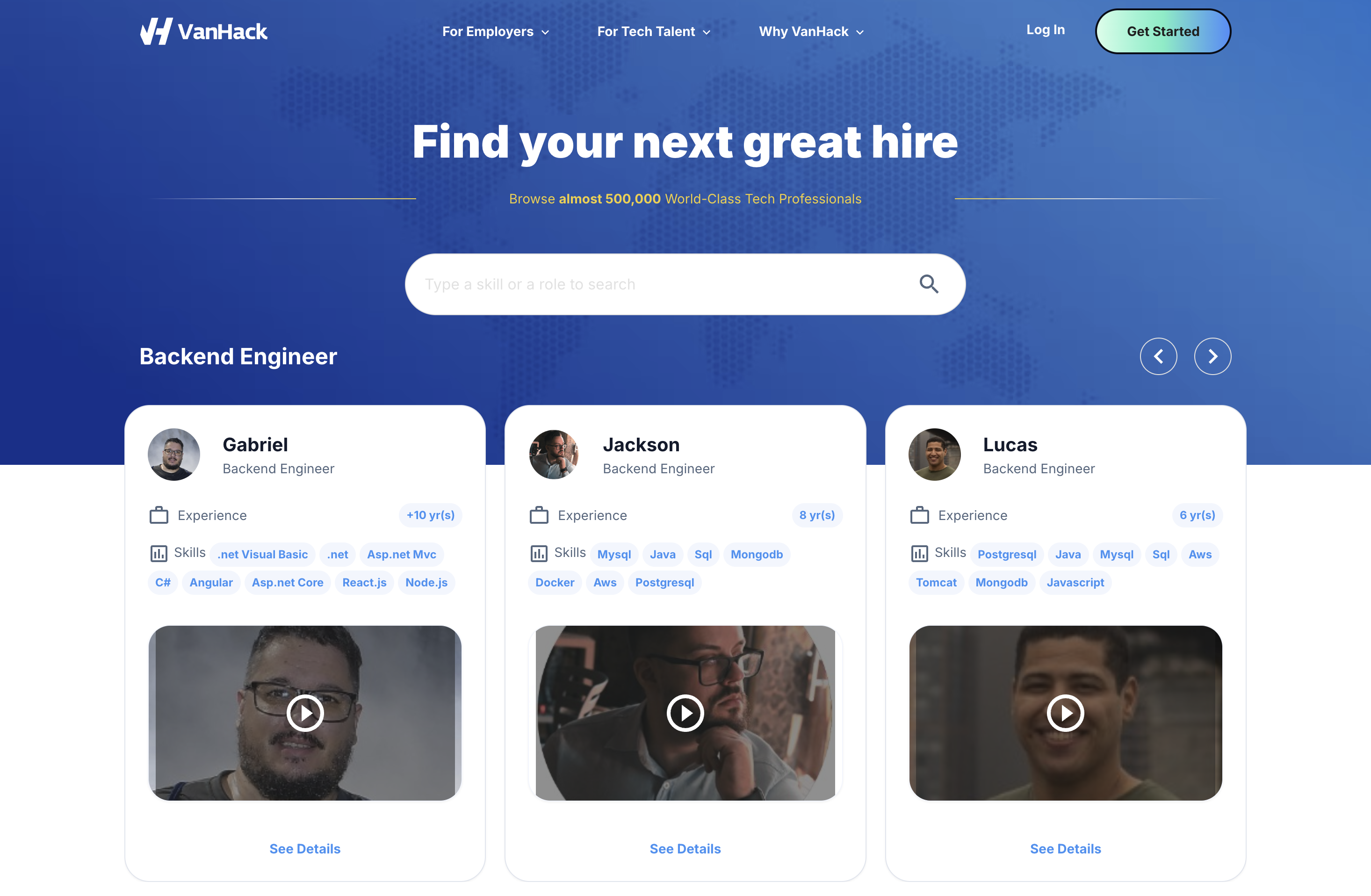US startups face intense competition for skilled software engineers, and traditional hiring methods often fall short when it comes to speed and efficiency. Latin American developers offer a valuable solution with their strong technical expertise, cultural compatibility, and time zone alignment, all at a competitive cost. By using targeted, AI-driven approaches to hire remote LATAM talent, you can build your team faster and stay ahead in a tight talent market. Hire smarter with VanHack using these seven practical strategies for international recruitment.

1. Use AI Matching to Source LATAM Developers Efficiently
Finding the right LATAM developers through old-school methods wastes time and resources. Generic job boards flood you with applications, forcing hiring managers to spend hours sorting through resumes without a clear way to assess technical skills, especially for international candidates.
For startups scaling fast, particularly from Series A to C, filling multiple roles at once makes manual screening impractical. Without a smart filtering system, you risk missing skilled developers buried in a sea of unqualified applicants.
AI matching changes the game by using advanced language models to analyze job needs and candidate profiles with precision. It looks at factors like salary range, relocation willingness, visa status, and cultural fit to narrow down the best matches. These tools go beyond resumes, pulling from detailed databases with verified skills, communication tests, and behavioral insights for remote work success.
VanHack’s AI tool, Vanna, scans a network of over 500,000 tech professionals, many from LATAM, to deliver a shortlist of 3-5 pre-vetted candidates. This cuts weeks of manual effort, letting you focus on interviewing only the most qualified prospects.
2. Test Remote Talent with In-Depth Asynchronous Vetting
Resumes and simple coding challenges don’t reveal enough about a candidate’s ability to solve real problems or communicate effectively, especially for senior roles. When hiring remote LATAM developers, you can’t rely on casual interactions to judge their skills or teamwork, making thorough vetting even more critical.
Remote work requires developers who can explain complex ideas, document their work, and stay connected across time zones. Standard tests or short live interviews often miss these qualities, which are vital for success in distributed teams.
Asynchronous vetting solves this by collecting detailed insights without scheduling hassles. Video introductions let you evaluate English skills, communication style, and professionalism upfront. AI-driven technical interviews, often 30 minutes long, record candidates solving problems and explaining their thought process, providing transcripts and scores for consistent, convenient review.
VanHack combines these tools into one platform, offering video intros, coding test results, and detailed AI interview recordings. This gives you a full picture of each candidate, streamlining decisions and saving time on early-stage screening.
3. Benefit from Cultural and Time Zone Fit with LATAM Talent
LATAM developers bring clear advantages for US startups beyond just cost savings. Their cultural alignment and similar time zones make remote collaboration smoother for US teams. Shared business values and communication styles reduce the friction common with other offshore regions.
With most LATAM countries just 1-4 hours different from US time zones, daily meetings and urgent tasks fit easily into regular working hours. This overlap supports agile workflows and keeps distributed teams connected without late-night calls.
Focus on key tech hubs like Mexico City, São Paulo, and Bogotá, where developers are skilled in cutting-edge tools and frameworks. When posting jobs, highlight collaboration with US teams, growth opportunities, and exciting tech challenges. Emphasize your startup’s mission and engineering culture to attract candidates who value impactful work.
Frame remote roles as a plus, showcasing flexible schedules, global exposure, and work-life balance. Connect with top LATAM talent by showing how your distributed setup benefits everyone on the team.
4. Choose a Predictable, Budget-Friendly Hiring Model
Traditional agencies often charge 20-25% of a candidate’s first-year salary, a heavy cost for startups hiring senior LATAM developers earning $80,000 to $120,000. Fees can hit $25,000 per hire, and for multiple roles, this quickly becomes unaffordable. Unclear timelines from agencies also complicate planning and delay critical projects.
Subscription-based hiring flips this model with a fixed monthly fee for unlimited hires, cutting costs for startups scaling teams. It offers budget certainty and encourages hiring the best talent without worrying about extra fees per person.
These modern platforms also provide clear tracking through dashboards and candidate pipelines, keeping you in control while tapping into expertise for international hiring.
VanHack’s Vanna subscription costs $3,000 monthly for unlimited hires. A startup hiring 7 developers paid $9,000 total, compared to over $100,000 with agency fees. This includes AI sourcing and vetting tools, offering a full, predictable solution. Scale your team affordably with VanHack.
5. Simplify Relocation and Global Mobility for Hires
Relocating international talent involves tricky legal and logistical steps that can overwhelm startups without immigration know-how. Visa processes demand exact paperwork and timing, varying by country and candidate. Missteps can delay hires or derail projects.
For candidates with families, the challenge grows with extra visa needs, schooling, and housing. Without expert help, startups risk visa denials or incomplete moves that waste months and leave roles open.
Strong mobility support includes visa handling by experienced consultants who manage paperwork and track progress. It also covers practical help like finding housing, arranging schools, enrolling in healthcare, and easing cultural transitions with community integration.
VanHack’s Global Mobility team takes on the full relocation process, from visas for candidates and families to logistics like housing. Included in their pricing, this service lets hires start remotely during processing, keeping projects on track while minimizing risks.
6. Value Soft Skills as Much as Technical Expertise
In remote setups, soft skills matter more since teams miss out on casual in-person interactions. Clear communication is key without visual cues or quick chats to resolve issues. Skills like adaptability and communication drive success for remote developers working across cultures and time zones.
Adaptability and cultural awareness help developers fit into diverse teams with varied work styles. Those with emotional intelligence and proactive attitudes build stronger connections and improve team dynamics from afar.
Assess these skills by observing candidates in real scenarios. Video intros show communication clarity and professionalism. Strong communication and organization signal cultural fit for international roles. In technical interviews, ask candidates to explain their reasoning and teamwork approach on complex tasks to see how well they share knowledge.
7. Create a Clear and Positive Candidate Experience
How you treat candidates shapes your ability to attract top LATAM developers in a competitive market. Slow responses or unprofessional processes can harm your reputation, turning away skilled talent who see the hiring experience as a reflection of your company’s culture.
A great candidate journey builds goodwill that lasts. Developers treated with respect often refer others, helping you reach talent who aren’t actively looking for jobs.
Candidates today want transparency, quick replies, and simple steps. Platforms with direct communication and easy scheduling cut friction, especially across time zones. Detailed profiles let candidates highlight their work through portfolios and projects, giving you deeper insight into their skills.
VanHack’s dashboard makes reviewing candidates intuitive while keeping communication open. Direct chat connects hiring managers with candidates, and one-click scheduling handles time zone differences. For relocated hires, local WhatsApp groups like “VanHackers in Toronto” help new arrivals settle in socially and professionally.
VanHack vs. Competitors: How It Stands Out for LATAM Hiring
VanHack blends sourcing, vetting, and mobility support into one solution, setting it apart in the market for hiring LATAM developers.
|
Feature/Benefit |
VanHack |
Traditional Agency |
Generic Job Board |
Other Talent Platforms |
|
Cost Model |
$3k/month unlimited hires |
20-25% first year salary |
$200-500 job posting |
Varies by platform |
|
Vetting Depth |
AI interviews + video intros + coding tests |
Basic resume review |
No vetting |
Varies by platform |
|
Global Mobility Support |
Full in-house team included |
Not included |
Not available |
Not always included |
|
Time-to-Hire |
3-5 pre-vetted candidates |
2-4 weeks sourcing |
Manual screening required |
Varies by platform |
Frequently Asked Questions About Hiring Remote LATAM Developers
What’s the typical salary for LATAM developers working for US companies?
Average annual pay for remote LATAM developers with US companies sits at $94,601. This offers savings over US-based hires while accessing skilled professionals with solid cultural fit. Pay varies by experience, specialization, and country, with senior roles earning more but still competitive compared to US rates.
How fast can I hire a LATAM developer with modern platforms?
Advanced platforms cut hiring time by offering pre-vetted candidates and efficient processes. With AI matching and asynchronous vetting, you can often finalize hires in 1-2 weeks, faster than traditional methods, depending on the depth of evaluation needed.
Which technical skills are most needed for LATAM developers?
High-demand skills include languages like Java and PHP, along with frameworks like React, Node.js, and TensorFlow. Cloud tools such as AWS and Azure, DevOps practices, and mobile development with React Native or Flutter are also key. Communication and remote collaboration experience round out the must-haves for distributed teams.
Can US startups find LATAM talent on general remote job boards?
Platforms like We Work Remotely and Remote OK draw LATAM developers seeking global roles. They’re affordable and wide-reaching but require you to handle all screening and vetting, which can slow down the process and miss top candidates without a focused approach.
What legal points should US companies consider for LATAM hires?
Hiring remote LATAM developers involves navigating tax rules, local labor laws, and intellectual property rights across borders. For relocations, visa compliance and ongoing legal status management are crucial, often needing expert advice to avoid issues.
Conclusion: Gain an Edge by Hiring Faster with VanHack
These seven strategies offer practical ways for US startups to tap into LATAM developer talent. AI matching, detailed vetting, cultural alignment, cost-effective models, relocation support, soft skills focus, and clear candidate experiences help you hire quickly while ensuring quality and managing budgets.
The benefits extend beyond single hires to building diverse, innovative teams that fuel growth. Adopting these methods lets you access talent that traditional approaches often overlook.
VanHack combines these elements into one platform for growing engineering teams with global talent. Ready to improve your hiring process and stay competitive? Find the right LATAM developers now with VanHack.



